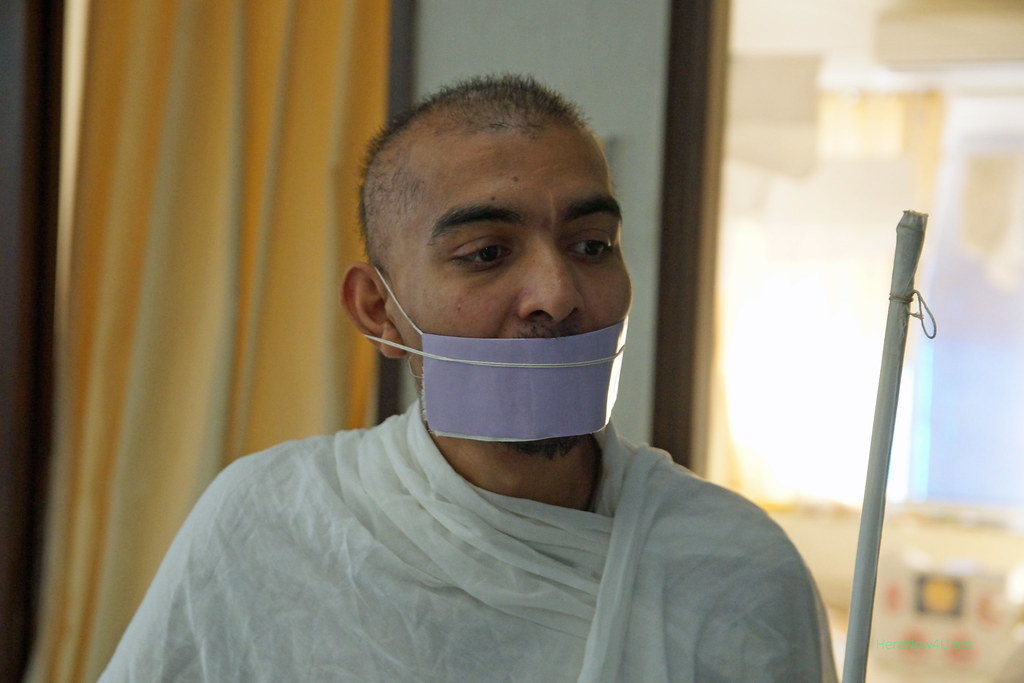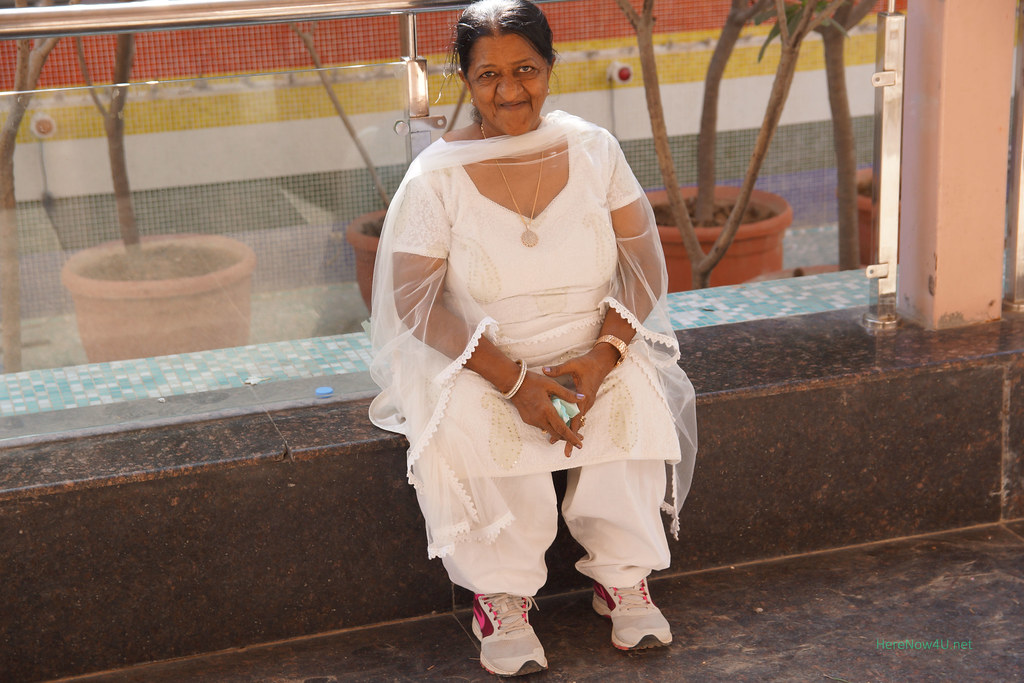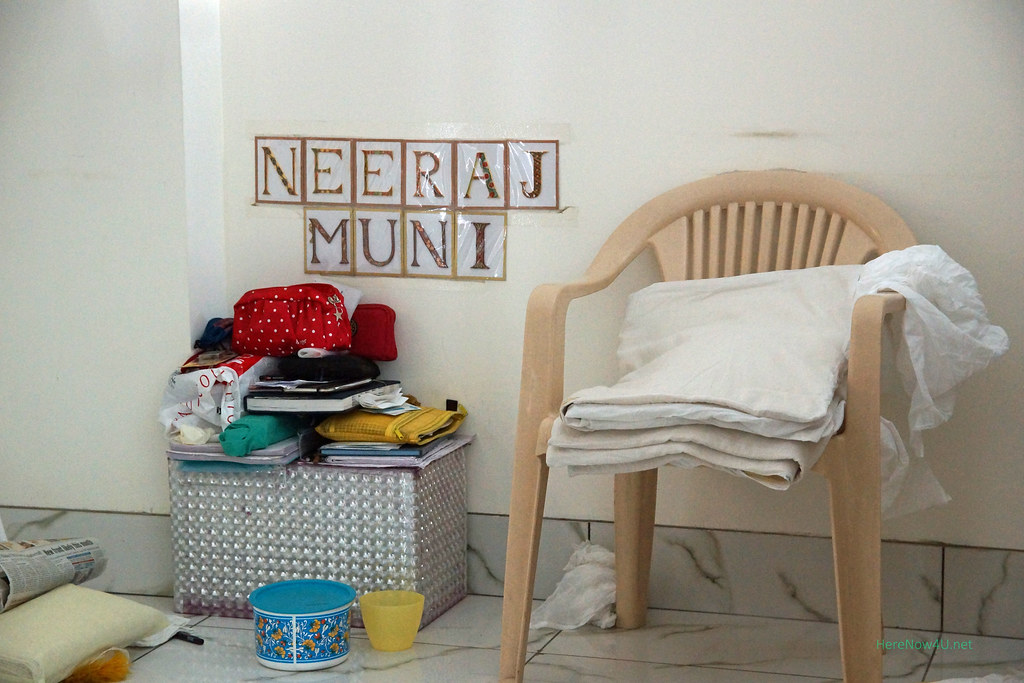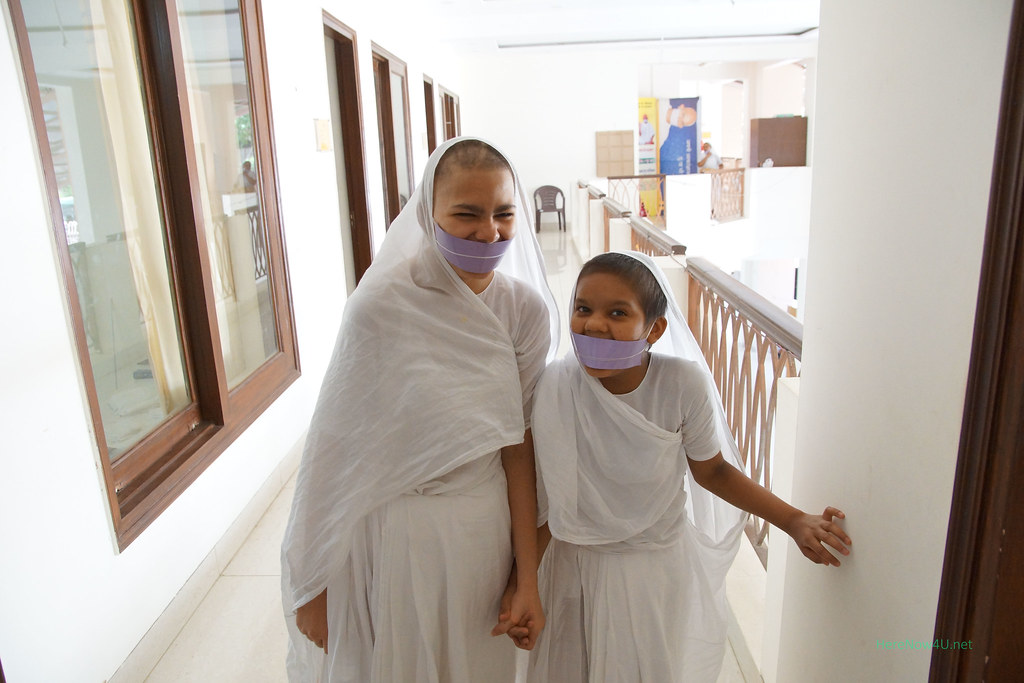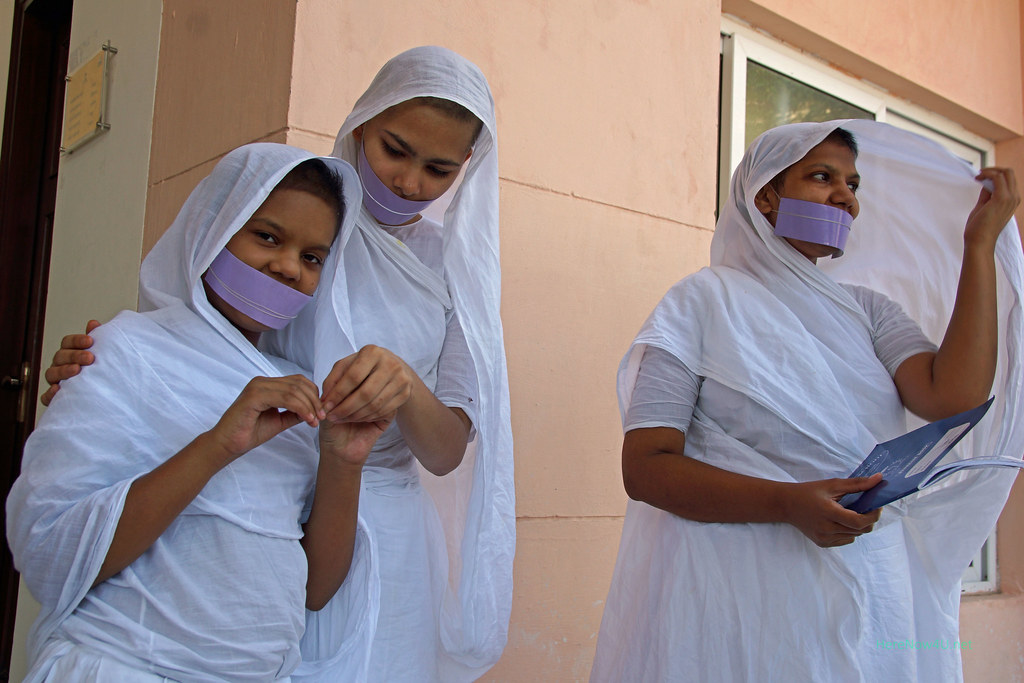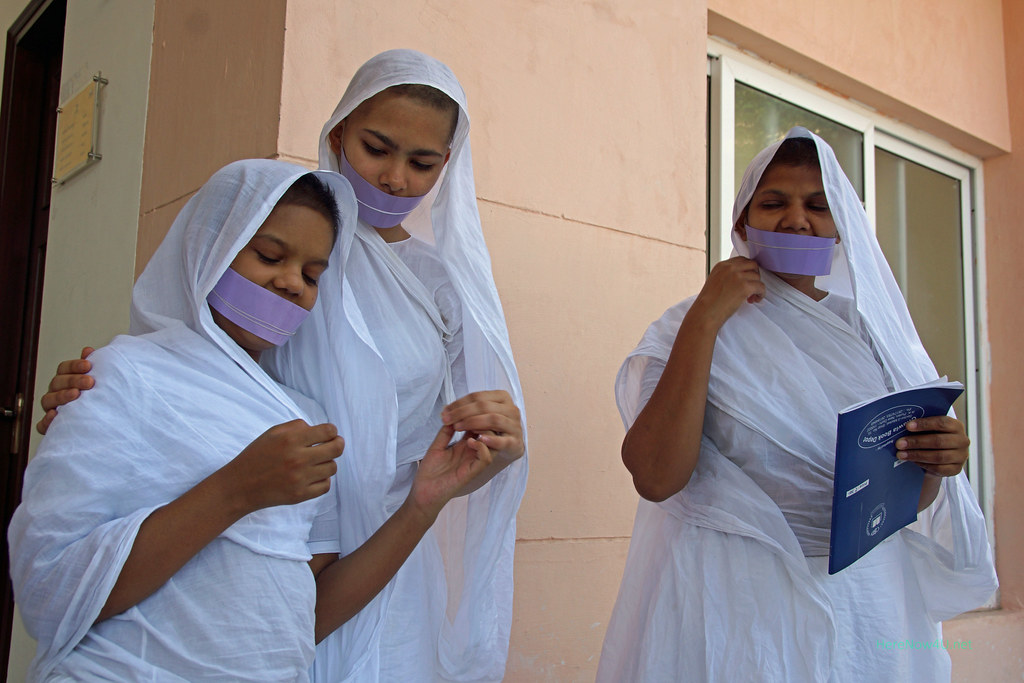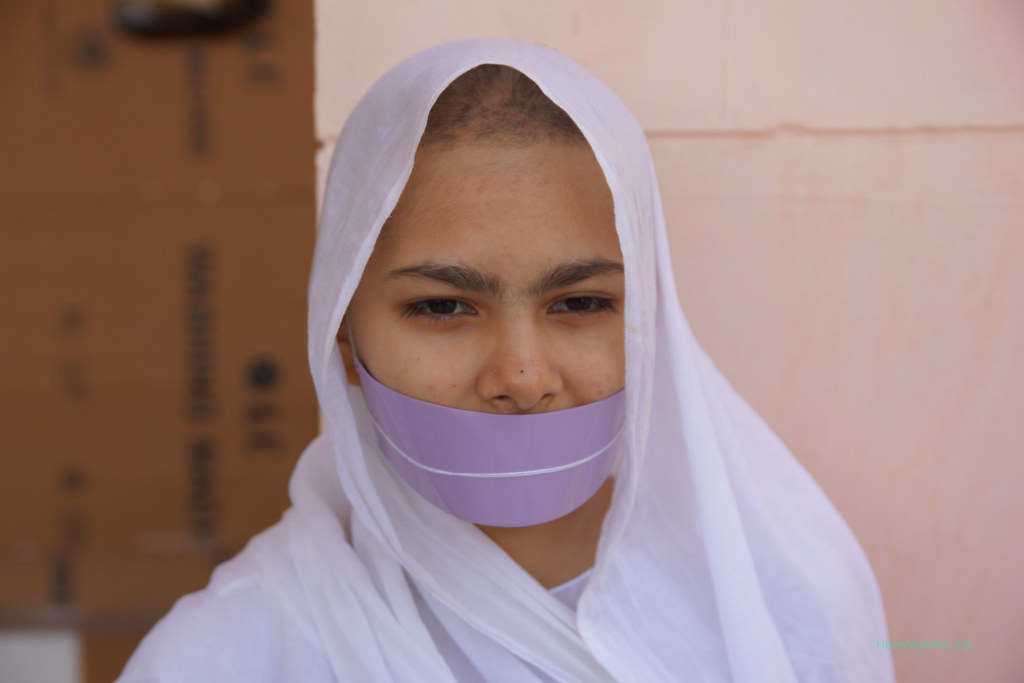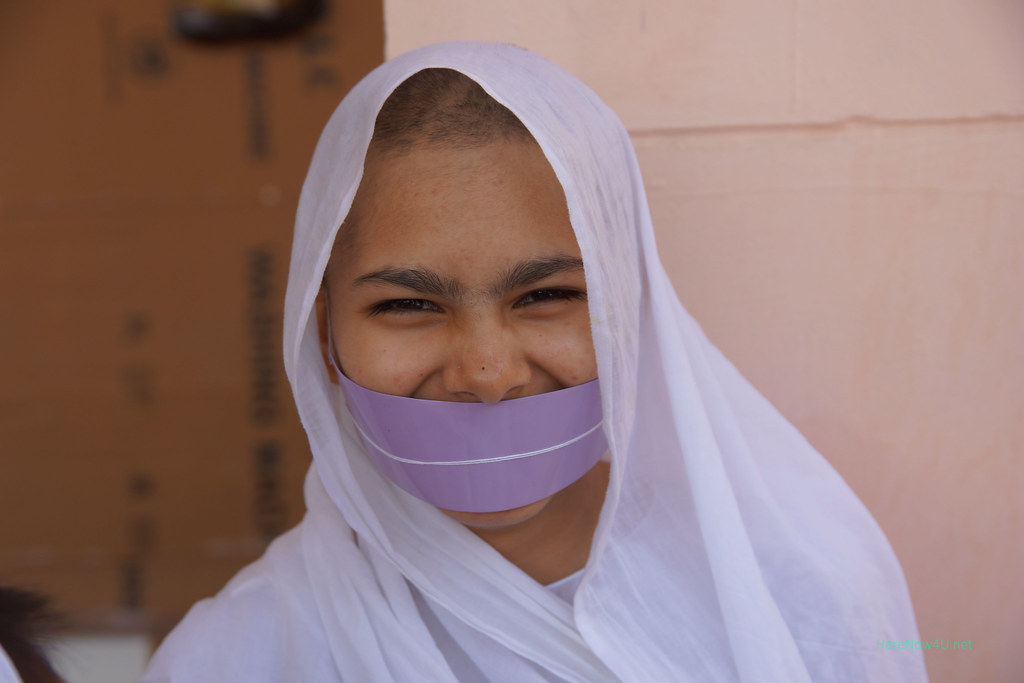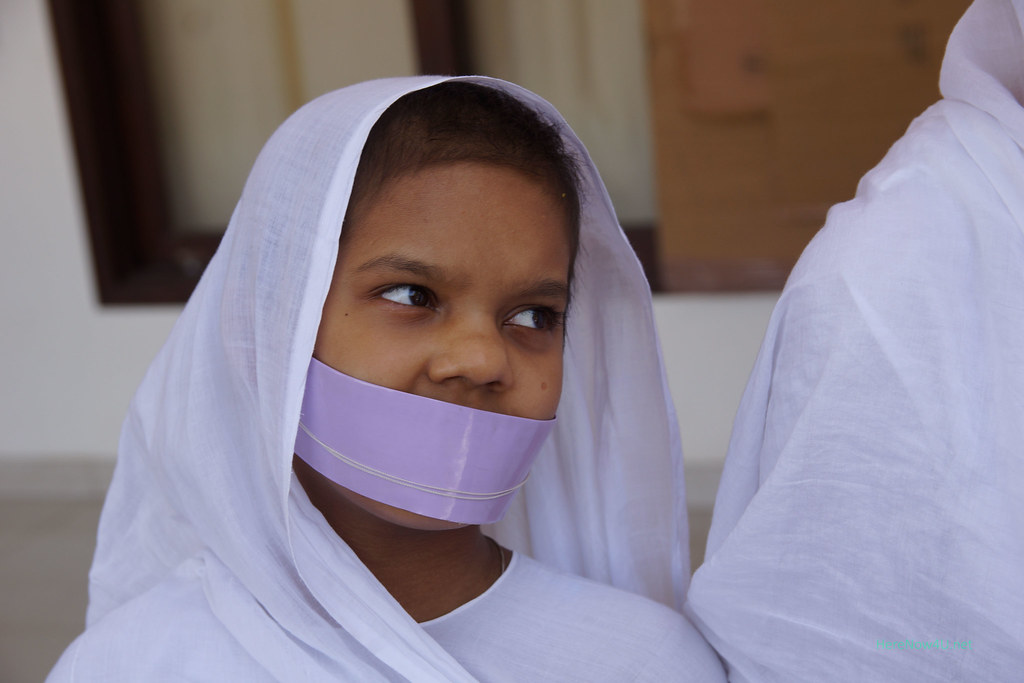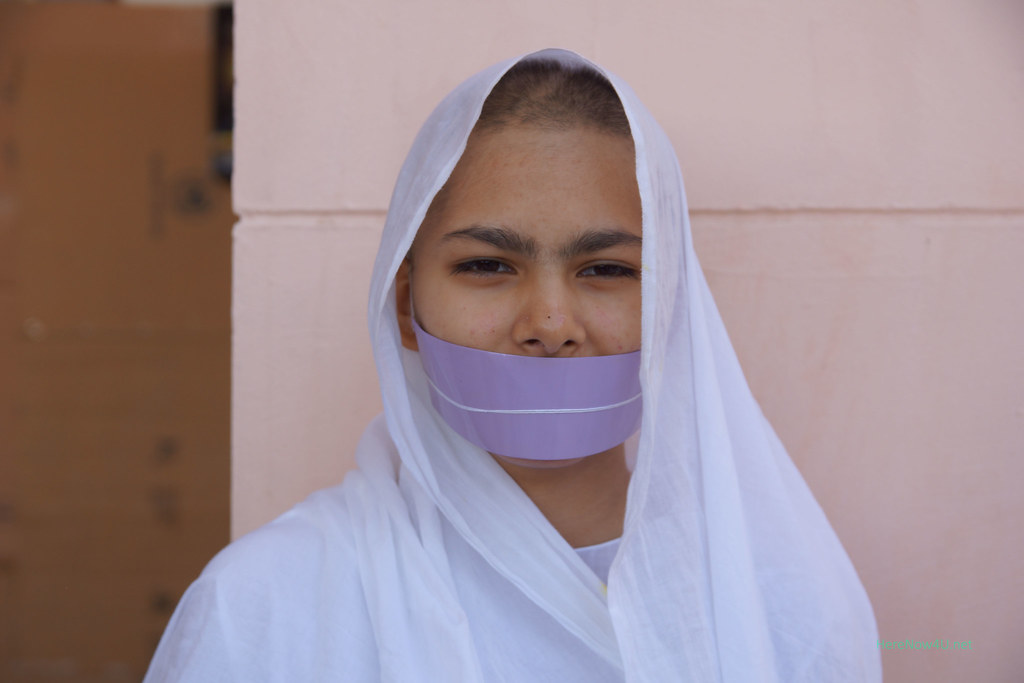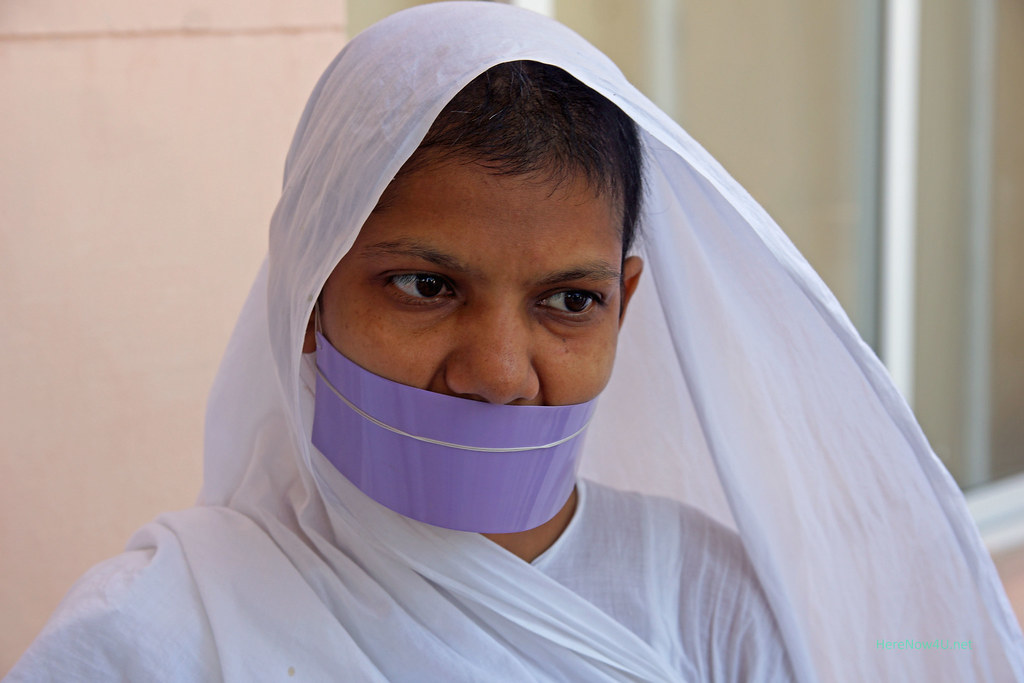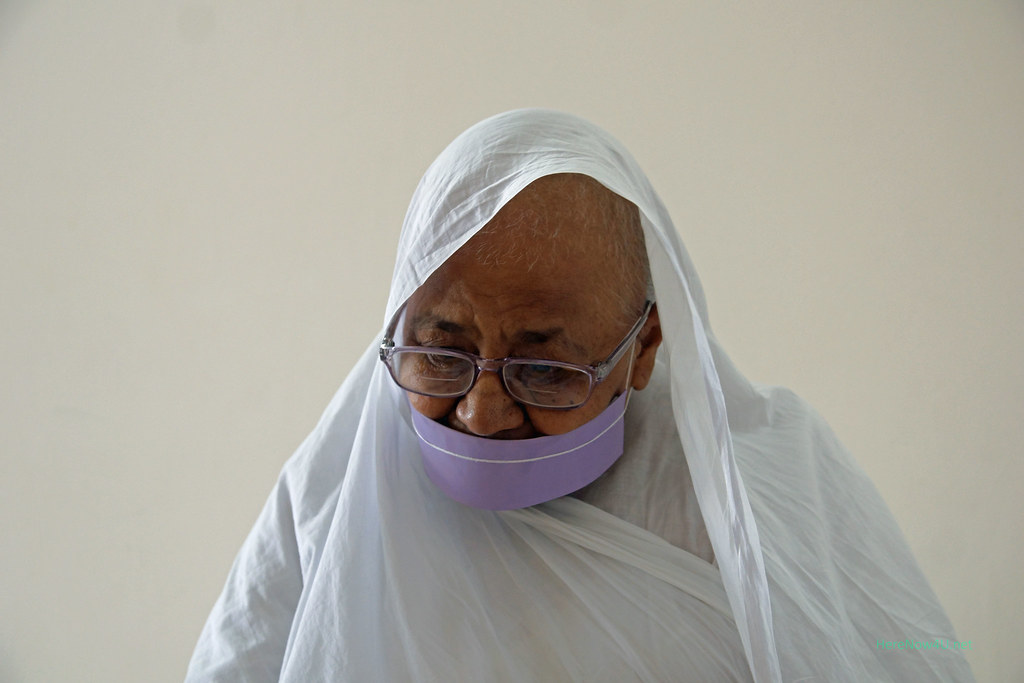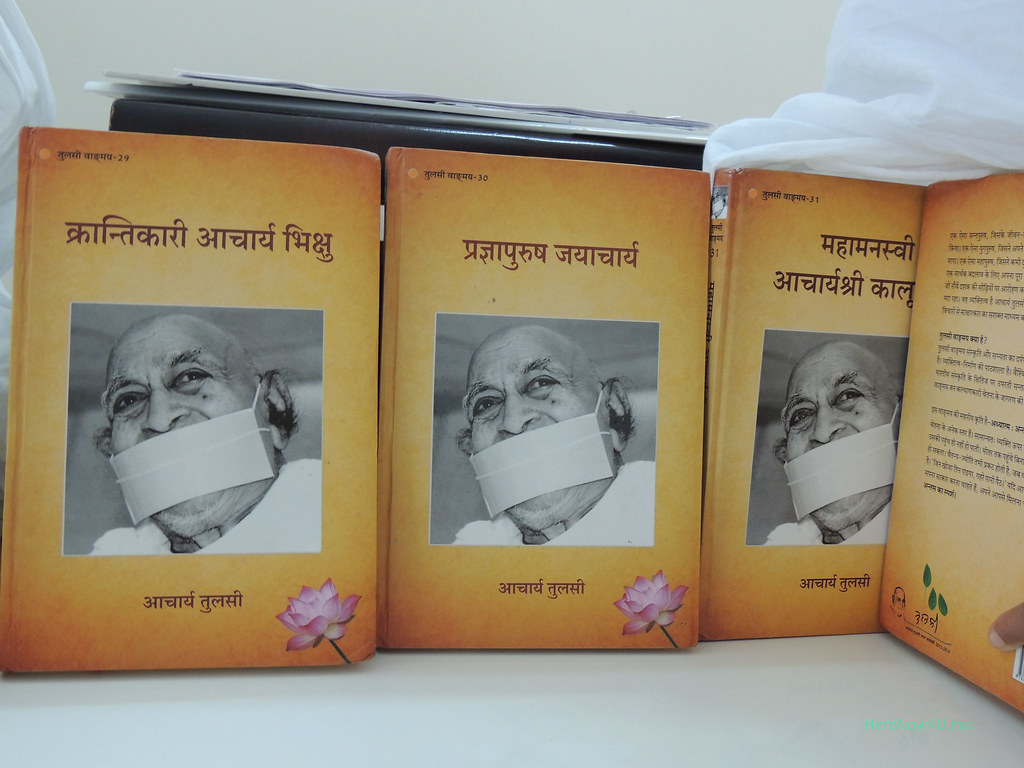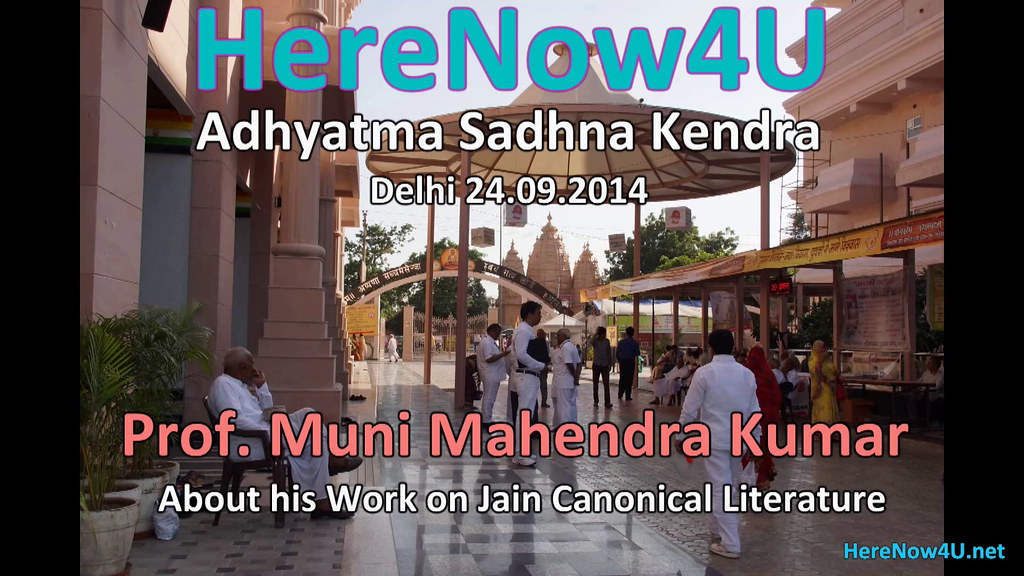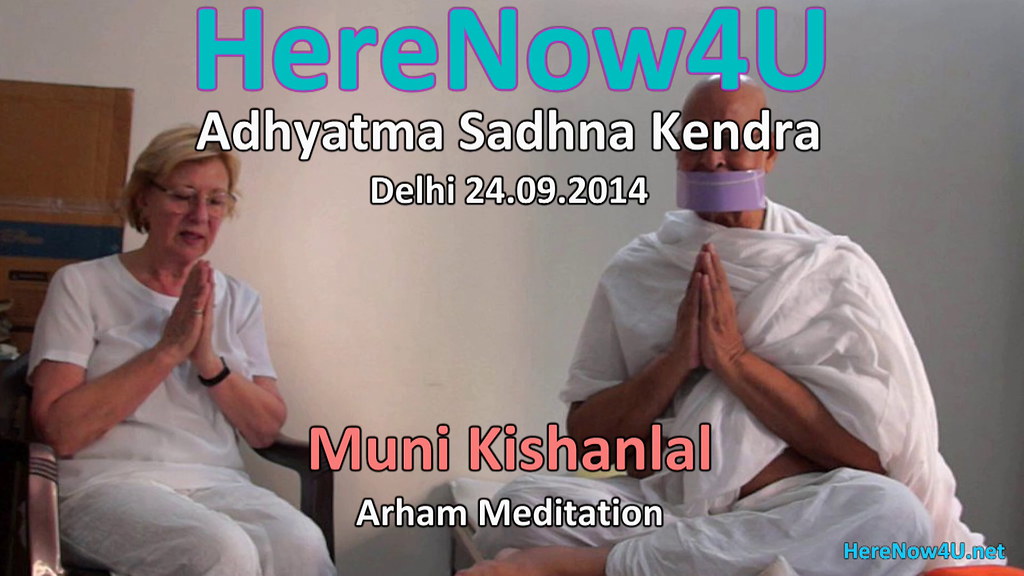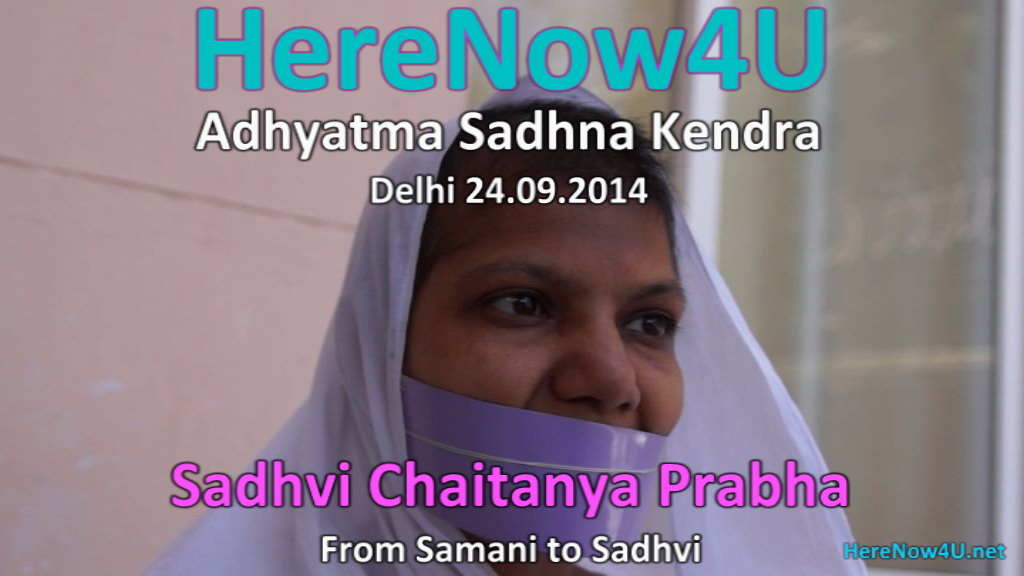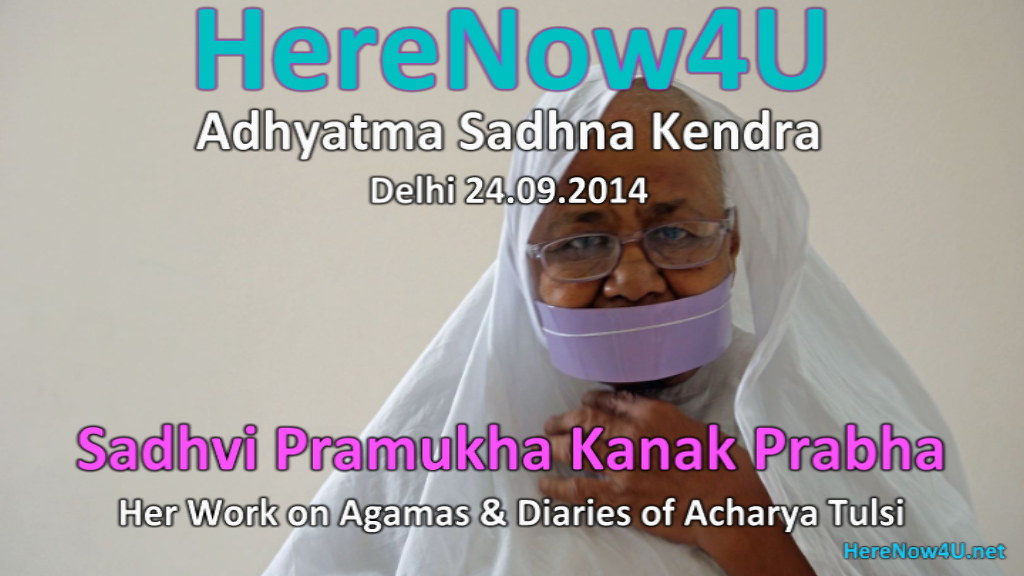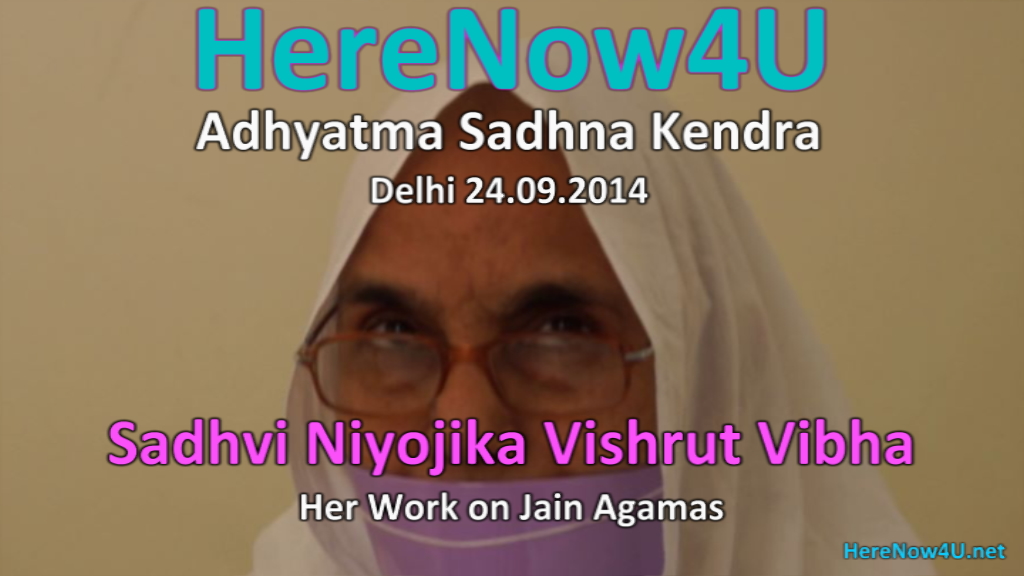This morning since getting up we were looking forward to the interviews Muni Mahendra Kumar ji, Muni Kishan Lal ji, and Muni Kumar Shraman ji had agreed to grant us at the full hour between 09:00 and 11:00h. We were more than happy that the monks had integrated our meeting into their busy schedule. Likewise Sadhvi Chaitanya Prabha, Sadhvi Pramukha Mahashramani Kanakprabha, and Sadhvi Mukhya Niyojika Vishrut Vibha had given time to us between 13:00 and 15:00h, also at the full hour. We supposed the saints’ cooperation a good omen, as for the next day an encounter with Surendra Borad Patawari, organiser of Anuvrat International Conference, was foreseen. In two days the start of the conference was scheduled, keeping us active there and leaving no more opportunity for interviews with the saints.
Muni Mahendra Kumar
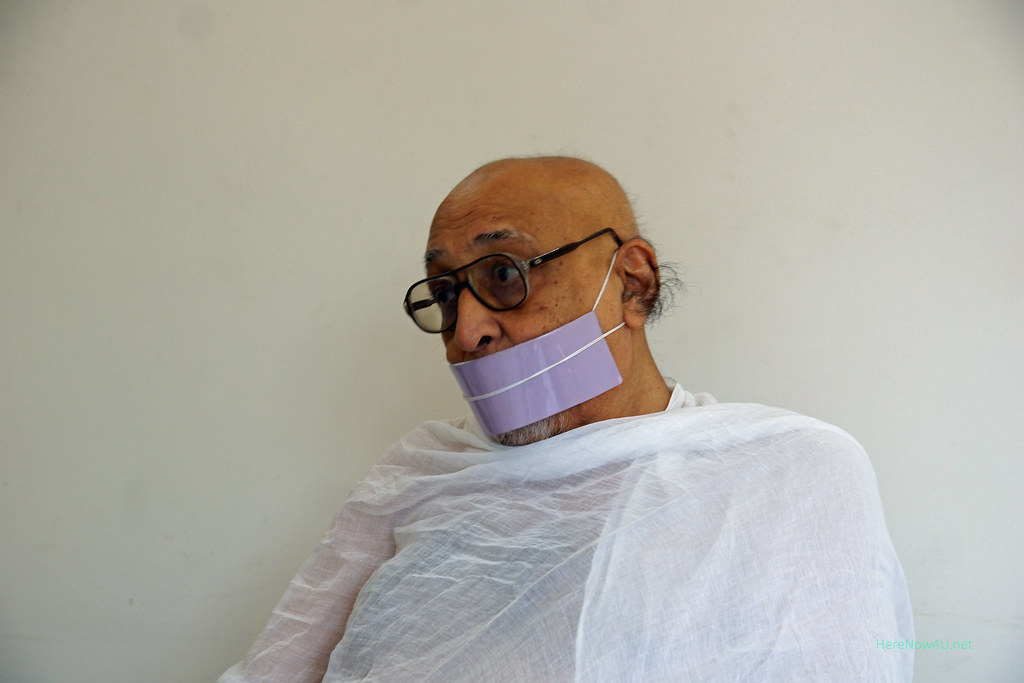
At 09:00h sharp Muni Mahendra Kumar awaited us in the midst of his many books and papers
Of course we asked Muni Mahendra Kumar in which task he was involved at present. To continue the work on the Jaina Canon is according to him the most significant task he was asked to accomplish. With this work he is continuing what Acharya Tulsi had considered in 1954 the task of the century and immediately had requested to Muni Nathmal, his future processor Acharya Mahapragya, to form a qualified team of monks and nuns able to respond properly to this challenge. In 1986 a choice of texts was presented to the public. Included were translations from Prakrit to Hindi, transfers from Prakrit to Sanskrit, and critical commentaries. This huge task was continuously performed by Acharya Mahapragya until the end of his mundane existence came nearer. Some months before he took his last breathe in May 2010 he handed this task over to Muni Mahendra Kumar. The latter was and still is asking himself why Acharya Mahapragya had entrusted leadership of the team to him, although he at this time still was enjoying good health. Perhaps it was an intuition. Acharya Mahashraman confirmed Muni Mahendra Kumar in this position to contribute to the completion of rendering all volumes in Hindi and Sanskrit, as well as providing critical commentaries. An English translation of all 7 volumes also is planned, some of them are in progress. These fundamental texts containing the insights of Jain saints and scholars are part of the Indian tradition and should be available for the Indian public as well as for the international scientific and interested community to not be buried in oblivion.
Video: Muni Mahendra Kumar

After thanking Muni Mahendra Kumar for his detailed statements and taking farewell from him, our minds were vibrating. To continue such a complex task for more than 60 years and neither to resign facing its complexity, nor giving up, can only be admired and highly esteemed. When we left Muni Mahendra Kumar he said that the ecological and sustainable teachings of this age-old tradition deserve to be conserved for mankind in a language people of the 21st century are able to understand.
Muni Kishan Lal
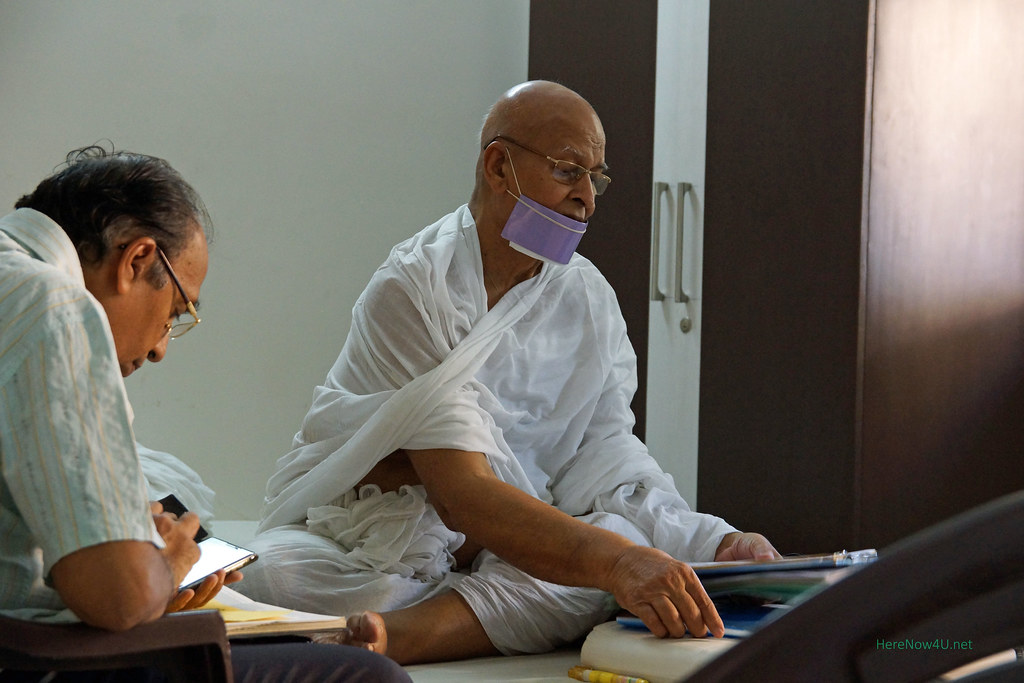
Muni Kishan Lal was still busy with visitors
When we arrived at the scheduled time in Muni Kishan Lal’s room, he was in a vivid discussion on the new release of a booklet on Jeevan Vigyan with 3 lay followers. A test version was already available, but seemed to contain some mistakes. “Since 35 years Muni Kishan Lal ji is active for Jeevan Vigyan,” one of them explained respectfully. We had requested Munishree to show two rather short, but very effective meditation practices among the many he is versed in. Arham Mantra Meditation was the one he demonstrated with me. In this meditation the Arham Mudra is combined with the sound of the Mantra, as is displayed in the video. Arham meditation is stimulating the flow of vital energy and results in feeling refreshed and activated most of all when the heart beat can be perceived in the fingers interlocked into each other. The Mantra is combined with the breath, inhaling on “Ar”, exhaling on “ham”. This can be seen very clearly in the video. Arham is the short formula of “Namo Arihantam”, the first line of Namokar Mantra. Thereafter Muni Kishan Lal demonstrated with Christian Geerdes the Mudras of Arihant, Siddha, and Acharya, being effective in revitalising body and mind when practiced regularly several times during the day.
Video: Muni Kishan Lal

Muni Kumar Shraman
It really was a very special morning when we met the monks. It appeared like having been coordinated what they told and showed us. All went together as theory and practice do at best, and it was likewise when we talked with Muni Kumar Shraman. Since our first visit to Terapanth Sangh we are acquainted to each other. Always near to Acharya Mahashraman, he belongs to the group of monks accompanying HH everywhere. He knows very well the internal structures of the order and told us some interesting details thereon.
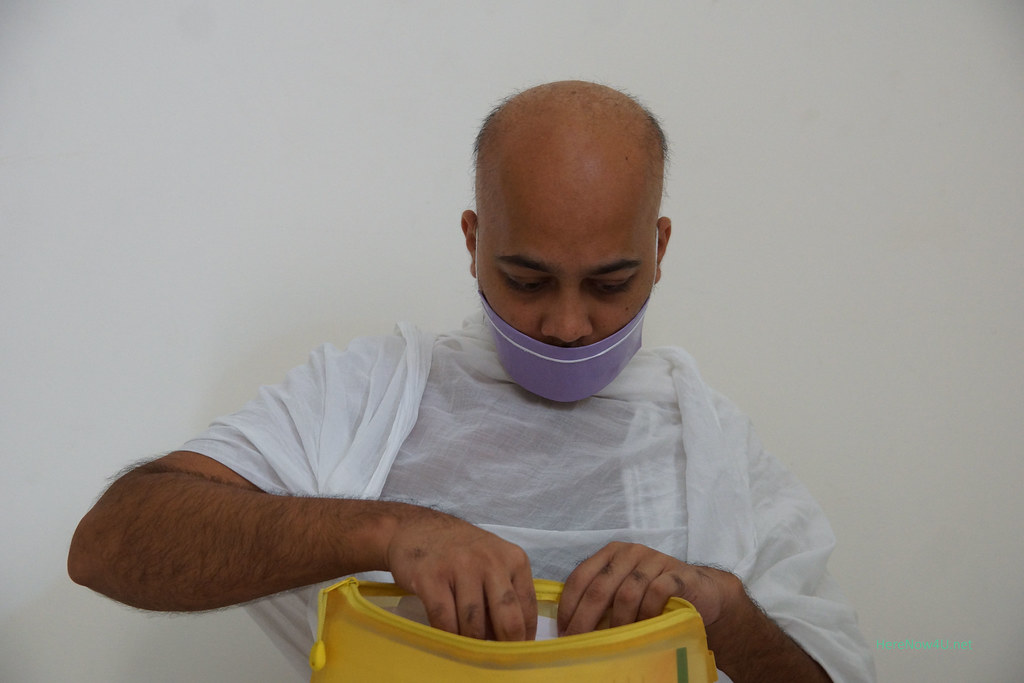
Muni Kumar Shraman
Amongst others his administrative task consists of organising accommodation and Gochari for the monks. Every monk is entitled to the same quantity of space for sleeping and the few belongings as clothes, personal hygiene articles and books. This has to be considered when they arrive at a new place and accommodation is allocated. For this purpose Muni Kumar Shraman receives a list of all houses suitable in terms of quantity, but not necessarily with regard to quality, for the saints’ accommodation. The nuns are staying at separate locations, and their arrangements are coordinated by Sadhvi Mukhya Niyojika Vishrut Vibha. Likewise a list of households ready for Gochari is compiled. Who goes when for Gochari in which household is chosen by the lot and sorted out by revolving mechanism to make sure nobody is omitted. During Chaturmas, every 4 days a new raffle will take place to ensure that all monks at least once are supplied with food by the households offering the same to them. Self-understood personal preferences concerning taste or combination of dishes are not at all in question. The monks close to HH further are responsible for all matters concerning his health. If necessary they are providing medical assistance in form of calling a doctor or fetching medication. In addition to their other obligations they are voluntarily doing this supplementary service. Muni Kumar Shraman e. g. is, together with Muni Jay Kumar, one of the two coordinators for International Preksha Meditation Camps.
At the end of our talks we moved on to Muni Kumar Shraman’s knowledge of some German phrases. After his initiation the still small boy was fond of foreign languages. Mr. Jhaveri, one of the worldly relatives of Muni Mahendra Kumar and speaking fluently German, at the occasion of one of his visits taught some phrases in German language to the young Muni, such as “Good morning, how are you, where are you coming from, etc.” Until present he remembers them, making us very much wonder to hear from him when we first met. It is understandable that in the future he hopes to receive lots of visitors from Germany, coming to the Sangh to be taught in Ahimsa, Preksha Meditation, and spiritu
Video: Muni Kumar Shraman

Sadhvi Chaitanya Prabha
After a short lunch break we hurried to our 13:00 h meeting with Sadhvi Chaitanya Prabha.
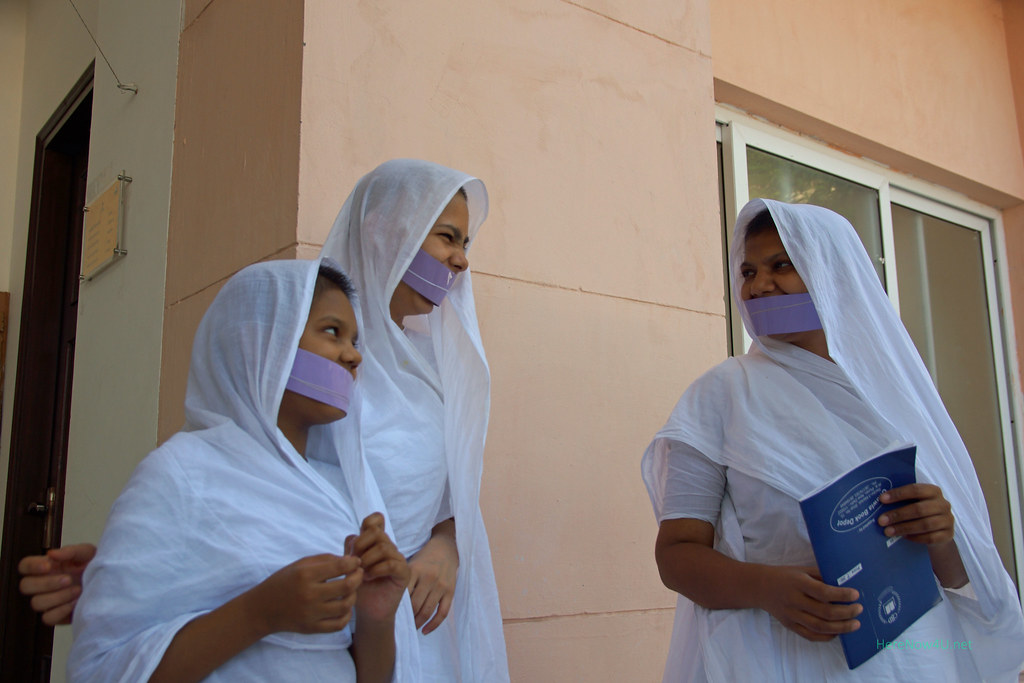
Sadhvi Prafulla Prabha (l) and Sadhvi Himanshu Prabha (m) were in her company until we started
In the court yard in front of the house where the nuns were accommodated we found a shady place with even a cooling breeze, rendering midday heat rather bearable for me. Sadhvi Chaitanya Prabha told us how her life had changed after she had taken Sadhvi Diksha. During her 10 years as Samani, to which she referred as her learning and teaching experiences, she was occupied with Anekantvad and Jain Yoga as an Assistant Professor at JVBU in the departments of Philosophy, Jainology, and Comparative Study of Religion. Mainly her task consisted in scientific study of the scriptures and preparation of manuscripts for university and conference lectures, as well as in its application in Jain Yoga. During her Samani time she felt more distance to practicing the teachings in every-day-life than in her present life as Sadhvi novice. Now theory has become practice for her, and that’s what is making her very happy. To her this gives the impression of liberation from earthly bondages, she increasingly feels lighter noticing the changes in her perception bringing her nearer to the shining lucidity of the spiritual goal. She is training to concentrate without side thoughts on what she is doing in the present, Bassa Samhiti, when she walks, she is concentrated on walking, when she speaks, she is concentrated on speaking. As Sadhvi novice she is not yet obliged to the many responsibilities she will have later, but more supposed to focus on the spiritual aspects of life. Further she regularly attends meetings in a group of novices where experiences of the new status can be exchanged. All this results in a deeper understanding of what is designating her life. She feels blessed by having had the opportunity as Samani to so-to-say being prepared on her practice as Sadhvi by then studying elaborately the scriptures her now every-day life is based on. Especially being near to Sadhvi Pramukha, in one of whose two groups she is, gives her inspiration and support to continually follow the path into hitherto unknown deep spiritual experien
Video: Sadhvi Chaitanya Prabha

Sadhvi Pramukha Mahashramani Kanakprabha
Since more than 40 years Sadhvi Kanakprabha is head of the nuns, and since 1979 also of the Samanis. Now she is under the third Acharya during her lifetime in this position and not only embodies continuity and reliability, but also the spiritual impacts of the three heads of the order. Notwithstanding, in her presence one immediately is at ease and relaxed. Her amiability and open- mindedness gave the impression to me that she is up to nearly all challenges life has to offer. Her nobleness of heart, dignity of character, and wisdom are resulting in qualities of leadership, unfortunately rarely to find. In her, high expertise in text comprehensibility, editing, and phrasing are united with poetry skills. Her knowledge of languages is concentrated on ancient and contemporary Indian languages, not on English. To help verbal communication getting settled in, a young nun of her group took over translation.

Sadhvi Pramukha Mahashramani Kanakprabha
Until two years ago she was the head of the female team working on the Agamas. Then she surrendered this task to Sadhvi Vishrut Vibha, administration manager of the female ascetics, because she became head of the team working on books dealing with the works of Acharya Tulsi and authored by him. This task had to be completed in time for the celebration of the latter’s centenary, and it was.

A selection of the books Sadhvi Kanakprabha had worked on with her team
There included were one biography and one autobiography based on the 15 diaries Acharya Tulsi had left over, 25 volumes all together. Besides she is the head of 550 nuns, 78 Samanis, and 50 Mumukshu sisters. Being asked how she succeeds in accomplishing her volume of work in the face of all the many people surrounding her constantly, she smiled and said that she gets her energy from Acharya Tulsi since the beginning until present. Furthermore she is trained to be able to concentrate her mind in the midst of a crowd and her good luck is to enjoy good health and not to need much sleep. She still is the first to get up between 03:00 and 03:30h and with 2 Sadhvis is reciting her Mantras then. Until 22:00h she is on her feet and only then she retires from public life. “Each and every Soul is equal and has unlimited capacities, Lord Mahavira teaches, and there he makes no difference between ladies and gents. Each and every one can reach her or his goals in life with hard work and persistence, no matter, if man or woman.” At the end of our talk she smilingly said, „Life is like ice cream, enjoy, before it melts.”
Video: Sadhvi Pramukha Mahashramani Kanakprabha

We took a little break to take water and looked around in the court yard. There an old acquaintance discovered me. We had met in 2008 at the occasion of a Preksha Meditation Camp in Jaipur.
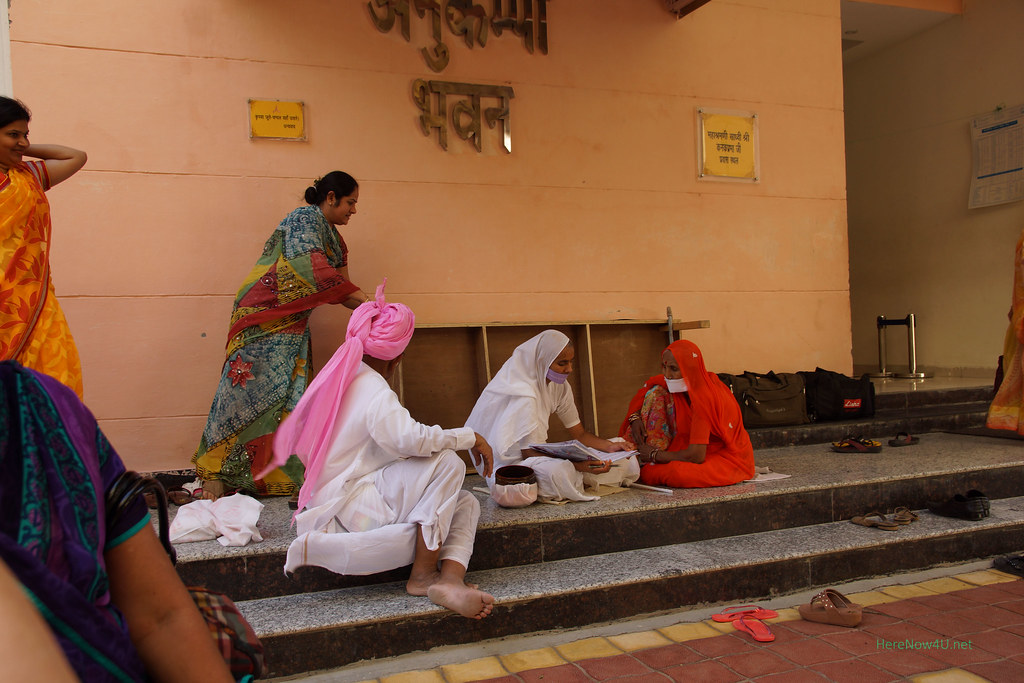
Visit of relatives
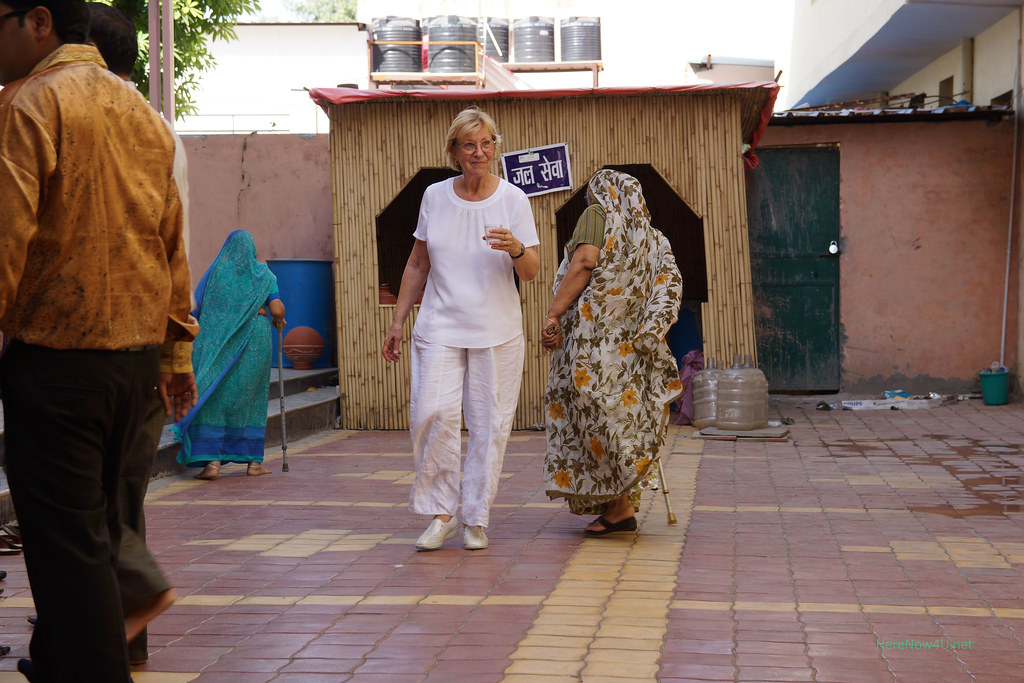
Fresh drinking water was always available

Carla Geerdes and Sarbi Dhardhia from Cuddalore (Tamil Nadu) are exchanging addresses
Sadhvi Mukhya Niyojika Vishrut Vibha
Sadhvi Vishrut Vibha shortly thereafter came back from her daily meeting with Acharya Mahashraman. Although she did not have much time because some of her relatives surprisingly had come to visit her, she did not cancel our talk. Of course we promised to make it short.

From rather far she had come with other relatives to visit her in worldly terms aunt Sadhvi Vishrut Vibha, and yet kindly agreed to the interruption of her visit caused by us

Sadhvi Vishrut Vibha
Sadhvi Mukhya Niyojika Sadhvi Vishrut Vibha also belongs to the team translating texts from the Agamas’ original Prakrit language into contemporary Hindi; resp. transfers them into classical Sanskrit. Only recently she had completed the 7th Anga (Upāsakadaśāh), which deals with the responsibilities of the lay followers. After that she had started to translate the critical commentaries titled “Phahajan Jain Shravakki”, authored by Acharya Mahapragya, into English. After some time she will do the same with Acharya Mahapragya’s Sanskrit literature. She also can realise her vast workload on one hand only with the energy she receives from Acharya Mahapragya. In his last years of life she was connected with him like a daughter and always near to him. “Sometimes,” she said, “I have the impression that he is near to me.” On the other hand she is applying her management skills also to her Self and is continually meditating. During her time as Samani she had visited Frankfurt, Idar-Oberstein and Berlin in the 1990ies and given lectures on Preksha Meditation there. Unfortunately at this time we did not yet know each other.
Video: Sadhvi Mukhya Niyojika Vishrut Vibha

 Editor Carla Geerdes
Editor Carla Geerdes


